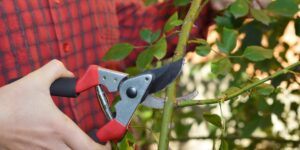
Monty Don urges gardeners to prune popular plant now
Colours are turning, leaves are falling, and fungi is thriving — the signs of autumn are firmly underway in our gardens.
But gardening expert Monty Don has warned that one job needs carrying out as soon as possible to avoid long-lasting winter damage.
On his gardening blog, the 68-year-old presenter has urged gardeners to tackle one job this month before the colder weather takes hold —pruning climbing roses.
Monty explains that “climbing roses flower on shoots grown the same spring, so they can be pruned hard now.” However, this is not the case for rambling roses, which produce their flowers on shoots grown the previous summer, so these should only be pruned immediately after flowering.


Pruning helps to remove dead and dying branches and stubs, allowing room for new growth, and is essential for ensuring that roses thrive. The best way to do it is to remove parts of the plant during its non-flowering season.
A good place to start is to firstly remove any signs of damage. Monty explains: “Start by removing any damaged or crossing growth or any very old wood, which can be pruned right back to the ground. The main stems should be fanned out at an equidistance as horizontally as possible, tying them to wires or a trellis. Then all the side shoots growing from these main stems — which produced this year’s flowers — can be reduced to a short stub of a couple of leaves.”
Monty explains that it’s important to cut climbing roses just above a bud that points in the direction that want the new stem to grow.
He says: “The effect should be a tracery of largely horizontal growth with pruned side-shoots running along their length. Finally make sure it is all tied firmly in to avoid winter damage.”
Also, always ensure you use sharp tools, as this will help achieve cleaner cuts and cause less damage to the plant.
He adds: “Always use a tool that is operating within its capacity, so never strain. Use loppers for stems too thick for easy cutting with secateurs and a sharp saw for anything that strains loppers.”
You Might Also Like

![iOS 18.0.1 coming soon with iPhone and iPad bug fixes [Update]](https://trend.slink.ph/wp-content/uploads/sites/11/2024/10/iOS-18.0.1-336x220.jpg)

